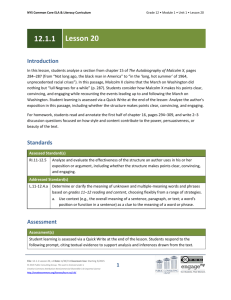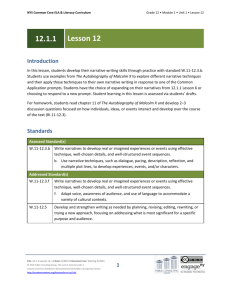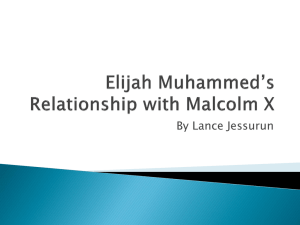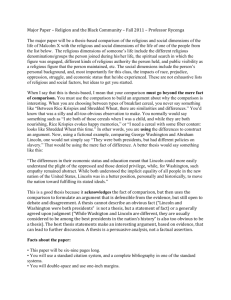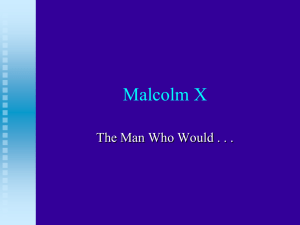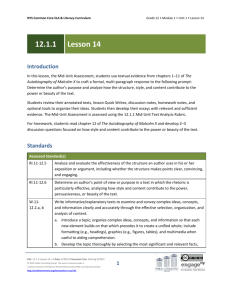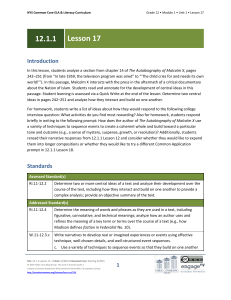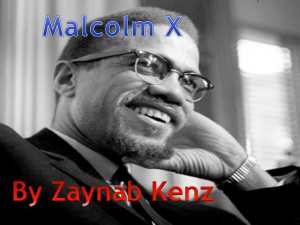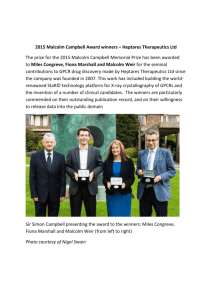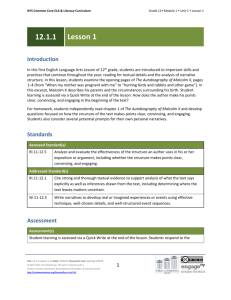Learning Sequence
advertisement
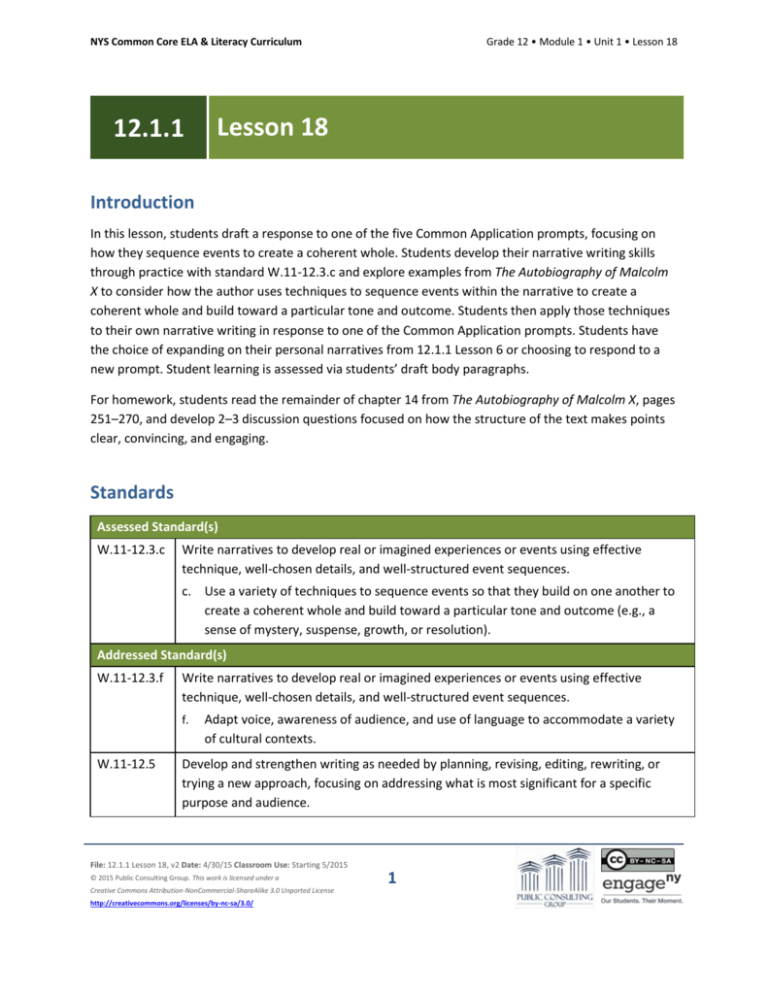
NYS Common Core ELA & Literacy Curriculum 12.1.1 Grade 12 • Module 1 • Unit 1 • Lesson 18 Lesson 18 Introduction In this lesson, students draft a response to one of the five Common Application prompts, focusing on how they sequence events to create a coherent whole. Students develop their narrative writing skills through practice with standard W.11-12.3.c and explore examples from The Autobiography of Malcolm X to consider how the author uses techniques to sequence events within the narrative to create a coherent whole and build toward a particular tone and outcome. Students then apply those techniques to their own narrative writing in response to one of the Common Application prompts. Students have the choice of expanding on their personal narratives from 12.1.1 Lesson 6 or choosing to respond to a new prompt. Student learning is assessed via students’ draft body paragraphs. For homework, students read the remainder of chapter 14 from The Autobiography of Malcolm X, pages 251–270, and develop 2–3 discussion questions focused on how the structure of the text makes points clear, convincing, and engaging. Standards Assessed Standard(s) W.11-12.3.c Write narratives to develop real or imagined experiences or events using effective technique, well-chosen details, and well-structured event sequences. c. Use a variety of techniques to sequence events so that they build on one another to create a coherent whole and build toward a particular tone and outcome (e.g., a sense of mystery, suspense, growth, or resolution). Addressed Standard(s) W.11-12.3.f Write narratives to develop real or imagined experiences or events using effective technique, well-chosen details, and well-structured event sequences. f. W.11-12.5 Adapt voice, awareness of audience, and use of language to accommodate a variety of cultural contexts. Develop and strengthen writing as needed by planning, revising, editing, rewriting, or trying a new approach, focusing on addressing what is most significant for a specific purpose and audience. File: 12.1.1 Lesson 18, v2 Date: 4/30/15 Classroom Use: Starting 5/2015 © 2015 Public Consulting Group. This work is licensed under a Creative Commons Attribution-NonCommercial-ShareAlike 3.0 Unported License http://creativecommons.org/licenses/by-nc-sa/3.0/ 1 NYS Common Core ELA & Literacy Curriculum Grade 12 • Module 1 • Unit 1 • Lesson 18 Assessment Assessment(s) Student learning is assessed via a response to the following prompt: Draft a paragraph in response to the Common Application prompt, focusing on using a variety of techniques to sequence events so that they build on one another to create a coherent whole and build toward a particular tone and outcome (e.g., a sense of mystery, suspense, growth, or resolution). Student learning will be assessed using the 12.1 Narrative Writing Rubric. High Performance Response(s) A High Performance Response should: Sequence events so that they build on one another to create a coherent whole and build toward a particular tone and outcome. (See examples below.) A shared passion for shoes creates an instant connection with people I meet, whether in a suburban shopping mall, or a trendy neon-lit Los Angeles sneaker store. I have learned that in some places, shoes are not a fashion statement or a status symbol. Rather, shoes enable a child to make an arduous trek to school and surmount a potential barrier to an education. When I first learned about the nonprofit organization, In Ian’s Boots, I knew I found a way to marry my shoe passion with my mission to contribute positively to the world around me. Ian’s Boots collects used shoes for people in need around the world and was founded by the grieving parents of a fellow soccer goalie killed in a sledding accident. Doctors found a biblical message in his boots urging “perseverance,” and this story and message spoke to me. Last year, I hosted a drive and collected over 600 pairs of shoes, some of which have been distributed to Honduras, Ghana, and Haiti. I am eager to continue my life journey at a college where my passion, entrepreneurial spirit, and desire to effect social change can intersect and be ignited by a powerful educational experience. In business and in service to others, I can only imagine all the places my shoes will take me next. Vocabulary Vocabulary to provide directly (will not include extended instruction) None.* Vocabulary to teach (may include direct word work and/or questions) None.* Additional vocabulary to support English Language Learners (to provide directly) File: 12.1.1 Lesson 18, v2 Date: 4/30/15 Classroom Use: Starting 5/2015 © 2015 Public Consulting Group. This work is licensed under a Creative Commons Attribution-NonCommercial-ShareAlike 3.0 Unported License http://creativecommons.org/licenses/by-nc-sa/3.0/ 2 NYS Common Core ELA & Literacy Curriculum Grade 12 • Module 1 • Unit 1 • Lesson 18 None.* *Because this is not a close reading lesson, there is no specified vocabulary. However, in the process of returning to the text, students may uncover unfamiliar words. Teachers can guide students to make meaning of these words using the strategies outlined in L.11-12.4.a-d. Lesson Agenda/Overview Student-Facing Agenda % of Lesson Standards & Text: Standards: W.11-12.3.c, W.11-12.3.f, W.11-12.5 Text: The Autobiography of Malcolm X as told to Alex Haley, Chapters 1–14 Learning Sequence: 1. 2. 3. 4. 5. 1. 2. 3. 4. 5. Introduction of Lesson Agenda Homework Accountability Writing Instruction: Sequencing Events Drafting and Assessment Closing 5% 20% 20% 45% 10% Materials Student copies of their personal narratives (refer to 12.1.1 Lesson 12) Student copies of the 12.1 Narrative Writing Rubric and Checklist (refer to 12.1.1 Lesson 2) Learning Sequence How to Use the Learning Sequence Symbol Type of Text & Interpretation of the Symbol 10% no symbol Percentage indicates the percentage of lesson time each activity should take. Plain text indicates teacher action. Bold text indicates questions for the teacher to ask students. Italicized text indicates a vocabulary word. Indicates student action(s). Indicates possible student response(s) to teacher questions. Indicates instructional notes for the teacher. File: 12.1.1 Lesson 18, v2 Date: 4/30/15 Classroom Use: Starting 5/2015 © 2015 Public Consulting Group. This work is licensed under a Creative Commons Attribution-NonCommercial-ShareAlike 3.0 Unported License http://creativecommons.org/licenses/by-nc-sa/3.0/ 3 NYS Common Core ELA & Literacy Curriculum Grade 12 • Module 1 • Unit 1 • Lesson 18 Activity 1: Introduction of Lesson Agenda 5% Begin by reviewing the agenda and the assessed standard for this lesson: W.11-12.3.c. In this lesson, students continue working with narrative techniques that sequence events to create a coherent whole and build toward a particular tone and outcome. They then apply these techniques to their own narrative writing. This work supports W.11-12.5, which asks students to develop and strengthen writing as needed by planning, revising, editing, rewriting, or trying a new approach, focusing on addressing what is most significant for a specific purpose and audience. Students look at the agenda. Activity 2: Homework Accountability 20% Instruct students to take out their responses to the previous lesson’s homework assignment. (Write a list of ideas about how you would respond to the following college interview question. Remember to keep in mind your task, purpose, and audience as you consider your response. Provide reasons for your opinions. What activities do you find most rewarding?) Instruct students to form pairs to ask and answer the college interview question. For this practice session, students should focus on giving examples to support statements they make about themselves. Students practice asking and answering the college interview question. Instruct students to keep their interview preparation notes in a writing journal or folder as a portfolio of their interview preparation throughout the module. Instruct students to take out their responses to the second homework assignment. (Respond briefly in writing to the following prompt: How does the author of The Autobiography of Malcolm X use a variety of techniques to sequence events to create a coherent whole and build toward a particular tone and outcome (e.g., a sense of mystery, suspense, growth, or resolution)?) Instruct students to talk in pairs about the responses they developed for homework. Student responses may include: o o In chapter 3, Malcolm X reflects on his younger self as he describes going to Boston for the first time: “If someone had hung a sign, ‘HICK,’ around my neck, I couldn’t have looked much more obvious” (p. 35). This structural choice helps the reader see Malcolm X’s later growth—as a narrator he is able to comment on his younger self. In chapter 9, when Malcolm walks up to Sophia at the bar, the author uses reflection and pacing to structure the events so that the reader can see what is going to happen. Malcolm explains why Sophia was there with her husband’s friend after Malcolm sees her in the bar. File: 12.1.1 Lesson 18, v2 Date: 4/30/15 Classroom Use: Starting 5/2015 © 2015 Public Consulting Group. This work is licensed under a Creative Commons Attribution-NonCommercial-ShareAlike 3.0 Unported License http://creativecommons.org/licenses/by-nc-sa/3.0/ 4 NYS Common Core ELA & Literacy Curriculum o Grade 12 • Module 1 • Unit 1 • Lesson 18 Malcolm comments on this reason: he states the man wanted “to visit ‘niggertown’ to be amused at ‘the coons’” (p. 150). Then the author skimps on the details and allows the reader to fill them in: “Then up I came. I know I called them ‘Baby’” (p. 151). Only the reactions of the women and the man are provided: “They were chalky-white, he was beetred” (p. 151). Providing few details and only the white people’s reactions creates a tremendous sense of tension. The author includes reflection in chapter 10, showing how Malcolm learned the information about “‘the true knowledge’” (p. 165). The narrative stops to allow Malcolm X to explain his “first reactions to all of this” (p. 166) to allow the reader to understand what was happening and how Malcolm grew from this experience. Instruct students to discuss in pairs the third homework assignment. (Reread your narrative response from 12.1.1 Lesson 12 and consider whether you would like to expand it into a longer composition or if you would like to try a different Common Application prompt in 12.1.1 Lesson 18.) Instruct students to review their statements of purpose from 12.1.1 Lesson 12 and consider which Common Application prompt best allows them to complete their purposes. Students discuss their decisions regarding the Common Application prompt. Activity 3: Writing Instruction: Sequencing Events 20% Remind students that, in crafting narrative essays, it is important to plan and control how the events are revealed. Explain that in The Autobiography of Malcolm X, the author deliberately structures events in different sections to draw the reader along. In some cases, the sequence and explanation of events creates a suspenseful tone, and in some cases, the sequence shows Malcolm X’s growth. Students listen. Instruct students to form pairs. Post or project each set of questions below for students to discuss in pairs before sharing out with the class. What can an author do to build suspense? Student responses may include: o o o Give hints about what is going to happen. Tell the reader what is going to happen, but not let a character know. Show something dangerous that will be happening to the character, but do not explain how the character will escape it. File: 12.1.1 Lesson 18, v2 Date: 4/30/15 Classroom Use: Starting 5/2015 © 2015 Public Consulting Group. This work is licensed under a Creative Commons Attribution-NonCommercial-ShareAlike 3.0 Unported License http://creativecommons.org/licenses/by-nc-sa/3.0/ 5 NYS Common Core ELA & Literacy Curriculum o o Grade 12 • Module 1 • Unit 1 • Lesson 18 Describe choices the character makes and then present the character with a situation in which he or she has a really important and difficult choice. Intentionally manipulate pacing so that the reader feels tension (e.g., short sentences that create a fast pace to imitate the fast pace of an event). Differentiation Consideration: If students struggle, consider posing the following question: What makes a story mysterious or suspenseful for a reader? Student responses may include: o o o Not knowing what is going to happen Hints that something bad will happen Clues that something bad has happened but it is not clear what Review pages 149–152 and identify how the author uses techniques to create suspense. Student responses may include: o o o He uses foreshadowing to prepare the reader for Malcolm’s arrest: “It’s a law of the rackets that every criminal expects to get caught” (p. 149), but he does not describe exactly what will happen. He describes two close calls that lead up to Malcolm’s arrest at the jewelry shop. He describes meeting Sophia’s husband’s friend, who breaks into his house and confronts him (pp. 150–151), and also describes confronting Detective Turner, who has been trailing him (p. 149). He breaks up the scene with Detective Slack into short, simple sentences. That varied syntax grabs the reader’s attention and creates a tense, nervous mood so that the reader anticipates that something bad is about to happen: “I didn’t try to shoot him. And that saved my life” (p. 152). Lead a brief whole-class discussion of student responses. If necessary, explain to students that the author uses several techniques to develop suspense in the text: o Foreshadowing, or giving hints about what is going to happen o Establishing character traits and habits before presenting the character with a difficult choice that forces him/her to leave his/her comfort zone o Using rhetorical devices, such as varied syntax, to manipulate pacing and powerful metaphors that increase tension File: 12.1.1 Lesson 18, v2 Date: 4/30/15 Classroom Use: Starting 5/2015 © 2015 Public Consulting Group. This work is licensed under a Creative Commons Attribution-NonCommercial-ShareAlike 3.0 Unported License http://creativecommons.org/licenses/by-nc-sa/3.0/ 6 NYS Common Core ELA & Literacy Curriculum Grade 12 • Module 1 • Unit 1 • Lesson 18 Explain to students that authors may use other narrative techniques to show growth in a character. Instruct student pairs to answer the following questions before sharing out with the class. How might an author sequence events to show growth in a character? Student responses may include: o o o o The author might mention what is going to happen, foreshadow events to come, and allow the character to comment on the events and describe how they helped him or her grow. The author might allow the character to reflect on the outcome of a situation, describing how the event changed the character. The author might slow down the description of the event, allowing the character to explain the decisions step by step. The author might present the event to allow the reader to draw his or her own conclusions about it, and then can have the narrator explain the events afterward. Differentiation Consideration: If students struggle, consider posing the following question: How do you know when a character has grown from his or her experiences? Student responses may include: o o o o The character thinks or acts differently. The character may say that the event “changed” him or her. The character may use figurative language to explain the growth, such as “my whole world shifted” or “I was a new person.” The character may reflect on his or her past actions or experiences and share differences or contrasts. Review pages 165–171 and identify specific ways in which the author sequences events to demonstrate Malcolm X’s growth. Student responses may include: o o The author begins the chapter by describing how Malcolm gained the nickname “‘Satan’” for being such a difficult inmate and for his “antireligious attitude” (p. 156) but is surprised and awed by “‘the true knowledge’” he hears: “When my sister, Hilda, had finished telling me … I don’t know if I was able to open my mouth and say good-bye” (p. 171). This scene highlights Malcolm’s transformation and growth because it shows that he has recognized his own past recklessness and that learning about Elijah Mohammad has awed him. The author includes statements of epiphany that show that Malcolm is trying to make sense of why the information is so meaningful to him: “The very enormity of my previous life’s guilt prepared me to accept the truth” (p. 167). He describes his transformation: “I was File: 12.1.1 Lesson 18, v2 Date: 4/30/15 Classroom Use: Starting 5/2015 © 2015 Public Consulting Group. This work is licensed under a Creative Commons Attribution-NonCommercial-ShareAlike 3.0 Unported License http://creativecommons.org/licenses/by-nc-sa/3.0/ 7 NYS Common Core ELA & Literacy Curriculum o Grade 12 • Module 1 • Unit 1 • Lesson 18 going through the hardest thing … to accept that which is already within you, and around you” (p. 167). These statements help show that Malcolm had an epiphany and is changed by what he heard that day. The author includes a significant last line: “Their silence left a vacuum into which any religious faker could step and mislead our people” (p. 171), which foreshadows further growth beyond the teachings presented here. Differentiation Consideration: Students may refer to their Character Development Tools for support, as needed. If necessary, explain to students that the author uses several techniques to show character development in the text: o Sequencing events deliberately so the reader can draw conclusions about how the character transformed o Reflecting on an event explaining what the character was feeling at the time or how he or she changed o Using statements of epiphany, including figurative language, in which the character explains the power of a moment and how he or she changed o Foreshadowing events or changes in a character Lead a brief whole-class discussion of student responses. Explain to students that they should use a variety of techniques to sequence events in their own personal narratives to create a coherent whole and build toward a particular tone and outcome. However, the scope of their personal narratives may focus on a much shorter amount of time and the events may be less intense than Malcolm X’s experiences. Explain to students that in order to choose which structural techniques to use, it is helpful to keep in mind the task, purpose, and audience. Instruct students to take out their statements of purpose from 12.1.1 Lesson 2 and consider whether they would like to revise their statements of purpose based on the work they have done over the past several days. Then direct students to Think, Pair, Share about the following questions: How does your task inform your choice of structural techniques? Student responses may include: o Given that their task is to write a 650-word narrative essay, students must choose structural techniques that fit this tight constraint, such as beginning in the middle of action, or concise descriptions. File: 12.1.1 Lesson 18, v2 Date: 4/30/15 Classroom Use: Starting 5/2015 © 2015 Public Consulting Group. This work is licensed under a Creative Commons Attribution-NonCommercial-ShareAlike 3.0 Unported License http://creativecommons.org/licenses/by-nc-sa/3.0/ 8 NYS Common Core ELA & Literacy Curriculum o Grade 12 • Module 1 • Unit 1 • Lesson 18 Since the task is to be succinct (650 words or less), students are unable to experiment with long-form structural techniques, and should probably limit themselves to straightforward and simple pacing. How does your purpose inform your choice of structural techniques? Student responses may include: o o o Given that the purpose is to distinguish oneself from other applicants in the pool, students will refine the structure of their essays to be as clear, succinct, and expressive as possible, while also including as much sophisticated narrative technique as possible within the short constraint (e.g., minor foreshadowing, brief flashbacks, etc.). Students should sequence events such that they seem reflective about a time in their lives, and aware of their own transformation. Because they mean to stand out from the crowd, if possible, students should include a series of moments leading to a moment of epiphany, since epiphanies tend to be singular and unique, not common. How does your audience impact your choice of structural techniques? Student responses may include: o o Students should sequence events such that the audience will have clear takeaways or understandings from their essays. Because the audience is apt to be well read and critical, the order in which students present the events in their narrative essays should make the conclusion seem not only logical, but inevitable. Lead a brief, whole-class discussion of student responses. Remind students to be mindful of their task, purpose, and audience as they structure their texts. Activity 4: Drafting and Assessment 45% Inform students that they are to use structural techniques like those they analyzed in The Autobiography of Malcolm X to continue drafting their responses to one of the Common Application prompts. Students may expand on the personal narrative they wrote in 12.1.1 Lesson 6 or choose a new prompt. Instruct students to discuss with a peer the structural techniques they plan to use in their essays and the tone they would like to create. Student responses will vary. File: 12.1.1 Lesson 18, v2 Date: 4/30/15 Classroom Use: Starting 5/2015 © 2015 Public Consulting Group. This work is licensed under a Creative Commons Attribution-NonCommercial-ShareAlike 3.0 Unported License http://creativecommons.org/licenses/by-nc-sa/3.0/ 9 NYS Common Core ELA & Literacy Curriculum Grade 12 • Module 1 • Unit 1 • Lesson 18 Consider reminding students to avoid using a negative tone (i.e., sarcastic, mocking, or judgmental), and to select an appropriate tone for their audience. Instruct students to work individually to respond to the following prompt: Draft a paragraph in response to the Common Application prompt, focusing on using a variety of techniques to sequence events so that they build on one another to create a coherent whole and build toward a particular tone and outcome (e.g., a sense of mystery, suspense, growth, or resolution). Consider drawing students’ attention to their work with W.11-12.3.f as they adapt voice and language use to reflect an awareness of audience. Remind students to use the 12.1 Narrative Writing Rubric and Checklist to guide their written responses. Students listen and read the writing prompt. Display the prompt for students to see, or provide the prompt in hard copy. Transition to the independent writing. See the High Performance Response at the beginning of this lesson. Instruct students to keep their personal narratives in a writing journal or folder as a portfolio of their narrative writing throughout the module. Activity 5: Closing 10% Display and distribute the homework assignment. For homework, instruct students to read and annotate the remainder of chapter 14 in The Autobiography of Malcolm X, pages 251–270 (from “Anyone who has listened to me will have to agree” to “Nothing that Mr. Muhammad ever said to me was more prophetic”). Instruct students to develop 2–3 discussion questions focused on how the structure of the text makes points clear, convincing, and engaging (RI.11-12.5). Instruct students to prepare possible answers to their questions for discussion. Students may also use the code WT to annotate for writing techniques that they identify in The Autobiography of Malcolm X and may use in their own writing. Students follow along. For Accountable Independent Writing homework, instruct students to continue drafting their personal narratives. Students may continue the draft they worked on during this lesson or choose to respond to a new Common Application prompt. Remind students to focus on using a variety of techniques to sequence events so that they build on one another to create a coherent whole and File: 12.1.1 Lesson 18, v2 Date: 4/30/15 Classroom Use: Starting 5/2015 © 2015 Public Consulting Group. This work is licensed under a Creative Commons Attribution-NonCommercial-ShareAlike 3.0 Unported License http://creativecommons.org/licenses/by-nc-sa/3.0/ 10 NYS Common Core ELA & Literacy Curriculum Grade 12 • Module 1 • Unit 1 • Lesson 18 build toward a particular tone and outcome (e.g., a sense of mystery, suspense, growth, or resolution). Homework Read and annotate the remainder of chapter 14 in The Autobiography of Malcolm X, pages 251–270 (from “Anyone who has listened to me will have to agree” to “Nothing that Mr. Muhammad ever said to me was more prophetic”). Develop 2–3 discussion questions focused on how the structure of the text makes points clear, convincing, and engaging (RI.11-12.5). Prepare possible answers to your questions for discussion. File: 12.1.1 Lesson 18, v2 Date: 4/30/15 Classroom Use: Starting 5/2015 © 2015 Public Consulting Group. This work is licensed under a Creative Commons Attribution-NonCommercial-ShareAlike 3.0 Unported License http://creativecommons.org/licenses/by-nc-sa/3.0/ 11
